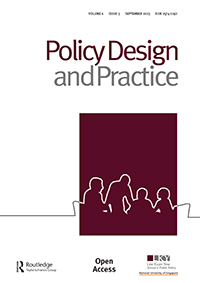The state’s role in governing artificial intelligence: development, control, and promotion through national strategies
IF 2.6
Q1 PUBLIC ADMINISTRATION
引用次数: 4
Abstract
Abstract Numerous governments worldwide have issued national artificial intelligence (AI) strategies in the last five years to deal with the opportunities and challenges posed by this technology. However, a systematic understanding of the roles and functions that the governments are taking is lacking in the academic literature. Therefore, this research uses qualitative content analysis and Latent Dirichlet Allocation (LDA) topic modeling methodologies to investigate the texts of 31 strategies from across the globe. The findings of the qualitative content analysis highlight thirteen functions of the state, which include human capital, ethics, R&D, regulation, data, private sector support, public sector applications, diffusion and awareness, digital infrastructure, national security, national challenges, international cooperation, and financial support. We combine these functions into three general themes, representing the state’s role: development, control, and promotion. LDA topic modeling results are also reflective of these themes. Each general theme is present in every national strategy’s text, but the proportion they occupy in the text is different. The combined typology based on two methods reveals that the countries from the post-soviet bloc and East Asia prioritize the theme “development,” highlighting the high level of the state’s involvement in AI innovation. The countries from the EU focus on “control,” which reflects the union’s hard stance on AI regulation, whereas countries like the UK, the US, and Ireland emphasize a more hands-off governance arrangement with the leading role of the private sector by prioritizing “promotion.”国家在管理人工智能方面的作用:通过国家战略进行开发、控制和推广
摘要在过去五年中,世界各地的许多政府都发布了国家人工智能战略,以应对这项技术带来的机遇和挑战。然而,学术文献中缺乏对政府所扮演的角色和职能的系统理解。因此,本研究使用定性内容分析和潜在狄利克雷分配(LDA)主题建模方法来调查来自全球的31种策略的文本。定性内容分析的结果突出了国家的十三项职能,包括人力资本、道德、研发、监管、数据、私营部门支持、公共部门应用、传播和意识、数字基础设施、国家安全、国家挑战、国际合作和金融支持。我们将这些职能合并为三个主题,代表国家的作用:发展、控制和促进。LDA主题建模结果也反映了这些主题。每一个总的主题都出现在每一个国家战略的文本中,但它们在文本中所占的比例不同。基于两种方法的组合类型显示,后苏联集团和东亚国家优先考虑“发展”主题,突出了国家对人工智能创新的高度参与。欧盟国家专注于“控制”,这反映了欧盟在人工智能监管方面的强硬立场,而英国、美国和爱尔兰等国则通过优先考虑“促进”,强调由私营部门主导的更为宽松的治理安排
本文章由计算机程序翻译,如有差异,请以英文原文为准。
求助全文
约1分钟内获得全文
求助全文
来源期刊

Policy Design and Practice
PUBLIC ADMINISTRATION-
CiteScore
10.30
自引率
4.30%
发文量
19
审稿时长
13 weeks
期刊介绍:
 求助内容:
求助内容: 应助结果提醒方式:
应助结果提醒方式:


